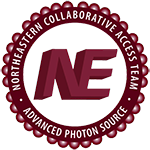Visualization of Covalent Intermediates and Conformational States of Proline Utilization A by X-ray Crystallography and Molecular Dynamics Simulations.
Publication Type:
Journal ArticleSource:
J Biol Chem, p.110532 (2025)Abstract:
<p>The bifunctional enzyme proline utilization A (PutA) catalyzes the two-step oxidation of L-proline to L-glutamate using proline dehydrogenase (PRODH) and L-glutamate-γ-semialdehyde dehydrogenase (GSALDH) domains. The two active sites are 42 Å apart and connected by a buried tunnel that is hypothesized to channel the intermediates Δ-pyrroline-5-carboxylate (P5C) and/or L-glutamate-γ-semialdehyde (GSAL). Kinetic and conventional X-ray crystallography of PutA from Sinorhizobium meliloti (SmPutA) were used to capture high resolution (1.47 - 1.88 Å) structures of states along the catalytic cycle, including a novel FADH-proline covalent adduct in the PRODH site, the intermediate P5C bound noncovalently in the reduced PRODH active site, the covalent acyl-enzyme intermediate of the GSALDH reaction, and noncovalent complexes of GSAL and the final product L-glutamate in the GSALDH active site. The FADH-proline covalent adduct resembles a stable species predicted from quantum mechanical electronic structure calculations of the PRODH reaction. The GSALDH domain complexes are consistent with conservation of substrate recognition and catalytic mechanism by the aldehyde dehydrogenase superfamily. The structure of reduced SmPutA with the P5C bound in the PRODH active site was used as the starting point for molecular dynamics simulations (21 x 2μs trajectories). P5C diffuses from the PRODH active site into the tunnel in most of the trajectories, but rarely dissociates completely from the enzyme, consistent with previous kinetic evidence of a substrate channeling mechanism. The simulations also provide insight into protein conformational changes associated with substrate channeling, including the opening and closing of a conserved ion pair gate.</p>
